I’ve decided to start a YouTube series on Media Ecology, based on my simultaneous research into Marshall McLuhan and the history of personal computing. I call it Media Ecology for the Online Community as Classroom in recognition of McLuhan’s insight that education was moving outside of schools in the information age. We are all now hunters, seeking out good information as though tracking down prey.
I hope this introductory episode sets the scene for a romp through the hidden layers of our very environment!
The rest of this post contains the text of my script and the presentation slides.
Hello! And welcome to Media Ecology for the online community as classroom. Today, right now, Billions of minds are being tethered together, all willy nilly. Billions of individuals are shaping and being shaped by one other at a rapidity with which institutions can hardly keep pace. All of us, on the internet, are building a world together. right now. and this world is quickly becoming the world. The amount of information, and breadth and scale of communication which digital-devices grant us demand a form of literacy and responsibility.
Ways of properly perceiving the whole, which is to say, indirectly conceiving ourselves in light of the whole, are essential. But where to start? Fortunately answers are to be found everywhere! For me, the answer has been street-smart media ecology.
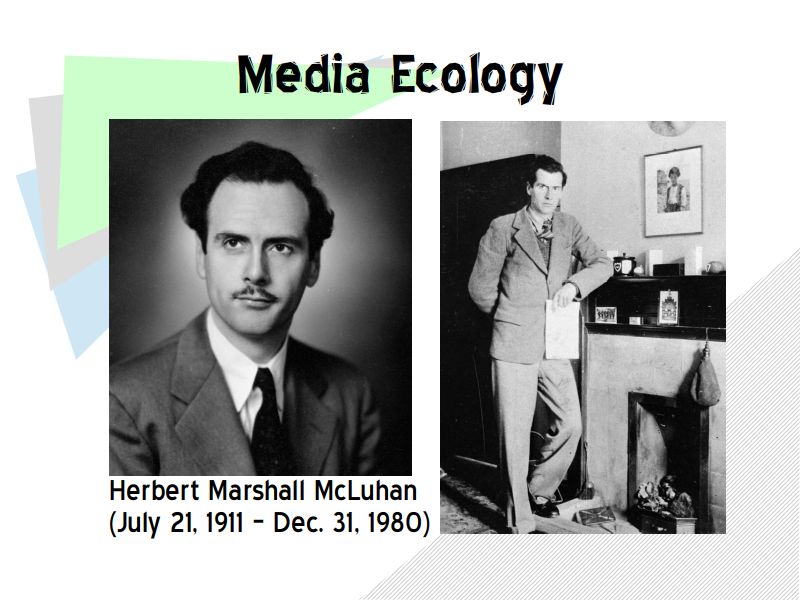
In the 1960s Marshall McLuhan said that, with the advent of television, more learning was done outside of the classroom than in it. For unstructured learning today Online Communities are where it’s at, and in participating in them responsibly, we will find Marshall McLuhan an ideal guide. He’s the central, if off-center, figure in the field of Media Ecology, which studies the role technology and media plays in our lives, as parts of our greater environment.
In the first part of this series, we will go over the life of this Canadian English professor who loved words so much he based an entirely new field of study on them. Like words, Marshall McLuhan saw *all* forms of media and technology as expressions and extensions of our selves — ways of reaching into and grasping the world which our senses report to us *and* vice versa. We will go over some of his major influences and interests so as to get an idea of the *problem* being addressed, and then we will consider the *solutions* McLuhan posited.
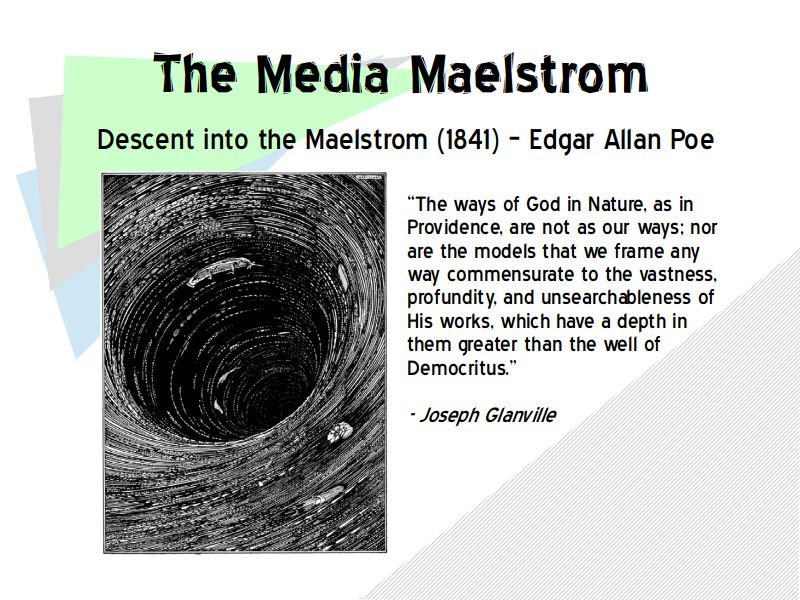
The problem is represented by the metaphor of the media maelstrom: consciousness lost in the dizzying, vertiginous whirlpool which has grown to encompass all the world since the industrial revolution of the 1800s. Derived from a short story by Edgar Allen Poe, the Maelstrom refers to the failure of our senses to restabalize after all our intuitions are knocked off kilter by disorienting developments in media, like photography, telegraph, cinema, radio, telephones, and television. Not only does the old way of sensing “stop working”, but how to even perceive the new way require fundamental changes sensory apparatus.
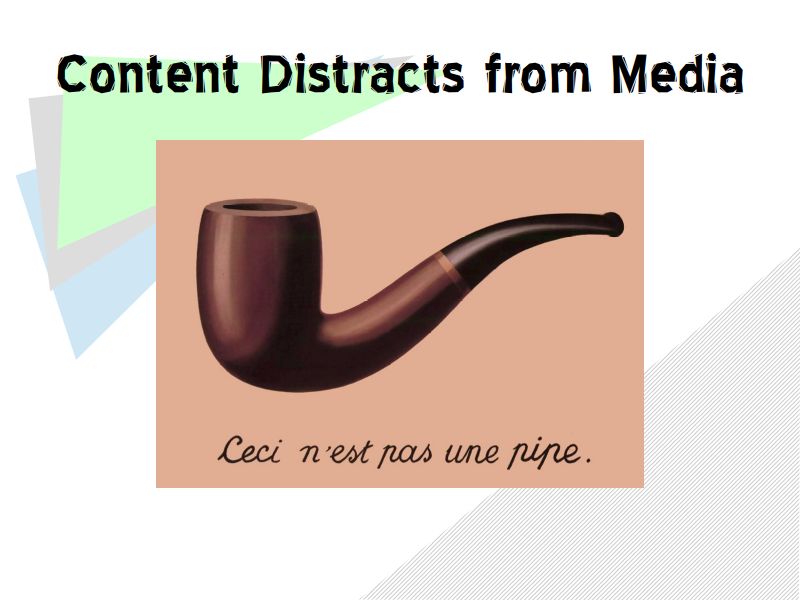
Compounding this problem, our old way of sensing is captured by new media a as a way to perceive it’s content. Instead of seeing the new, we see the old within the new. To look at a painting or a television, or to listen to streaming music, we will notice the content first– the image or the music. The paint-strokes or pixels or audio compression algorithm would only be secondary considerations, if we are conscious of them at all. Our senses are superficial by default. The new environment, which takes forms of sensation we lack incentive to develop, remains invisible while they play pretend at being the old, familiar thing.
In addition: Mechanization, advertisements, propaganda spectacular media and the incessant bombardment of all the world’s ideas and cultures and histories and news upon our persons leave our rational faculties bouncing about in our brains in fragments, unable to synthesize comprehensive thoughts. Without words and art to order your senses in this chaos, one was helpless but to be living largely unconsciously.
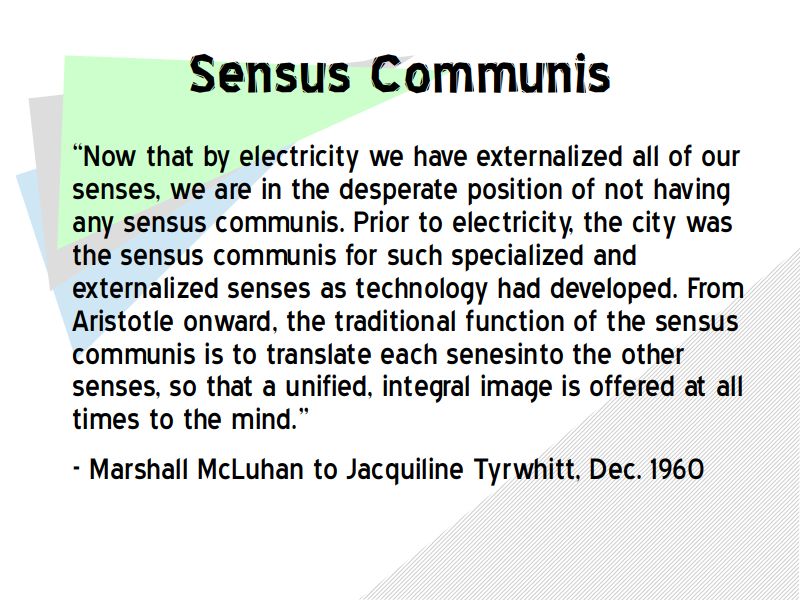
In the face of science, industry and mass production’s erosion of traditional human beliefs and values, the solution of the Romantic poets, a return to nature, did not work. After careful consideration, years of development, McLuhan’s proposal was the development of ways navigating the maelstrom called media literacy. It’s end goal was the establishment of a sensus communis or common sense. The main idea is that people don’t come together by empathizing with each other, directly. Communication isn’t a person-to-person operation, transporting messages back and forth. Instead, it is shared perception, a co-created common sense of what is fundamental and stable and true, about which people come together. Common sense comes with verifiable integrity of touch, sight, and sound all in interrelation. The dream is that through good artwork, true words, self-education, and responsible, conscious ownership and use of our technology, the human-created world itself might to be made into something sensibly steady and stable, providing the mind objects of contemplation which allow for personal orientation.
In our age of radio waves and microelectronics, much that is real is beyond our senses to immediately pick up. A sense for all that is real, but remains invisible, such as germs, or carbon monoxide, must be trained. But, even before then, let’s not forego the obvious. It’s the obvious stuff, that which is taken-for-granted, that is always at risk of erosion if not recognized and renewed by taking notice. Knowing what we’ve got before it’s gone is the key, and that takes conscious articulation.
The world is full of so much more things to come together on, so many more things, than that last resort of the lost and the damned, the common-enemy. Instead of continuing to allow necessity to force our hand in regard to what brings people together, we must be pro-active, conscious about all that it is which we already share.
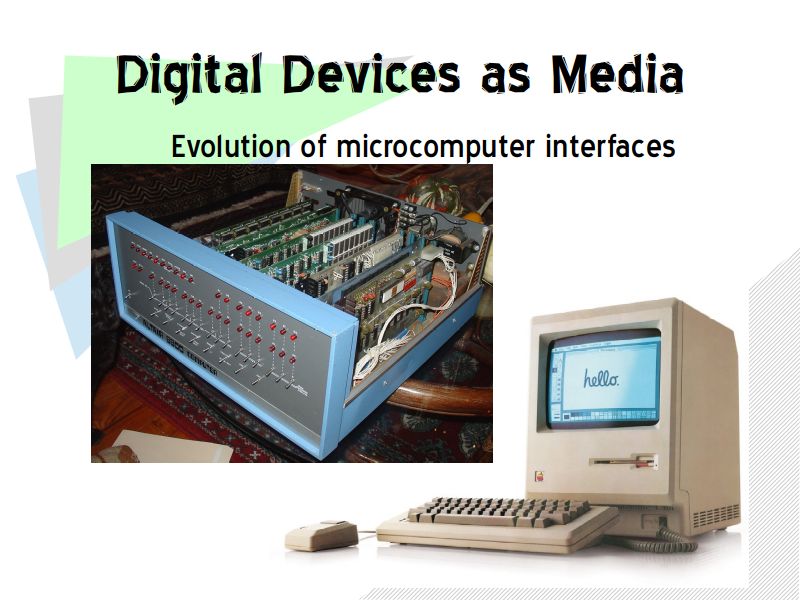
Well, that’s still pretty Romantic, isn’t it? But it’s a good ideal to set our sights on! Because it’s realistic. The starting point is to find out what is undeniably real, and that we all share, and that we ought to agree on. And what’s one thing we all share?
Well, we’ve got our noses buried in screens all day! And that’s what this show is about: computer literacy for the purposes of media ecology. We are going to get a *sense* of digital devices as media in-and-of-themselves, instead of the content. Please shut up about apps, forget the apps, you’re not ready for apps if you don’t understand Alan Turing’s conception of the Universal Machine. I don’t know who the hell gave you a pocket-sized super-computer, but I know you’re not licensed for that thing, and so this will be your safety course, for the sake of *my* peace of mind! We’ll track how to the Turing Machine gets buried beneath the evolving interfaces of microcomputers from the 1970s to the present day. This will let us peak behind the illusory extensions of our physical environments which modern computer interfaces simulate. This story of Cyberspace — the merging of virtual objects and real space — has already been covered in my other series, Silicon & Charybdis.
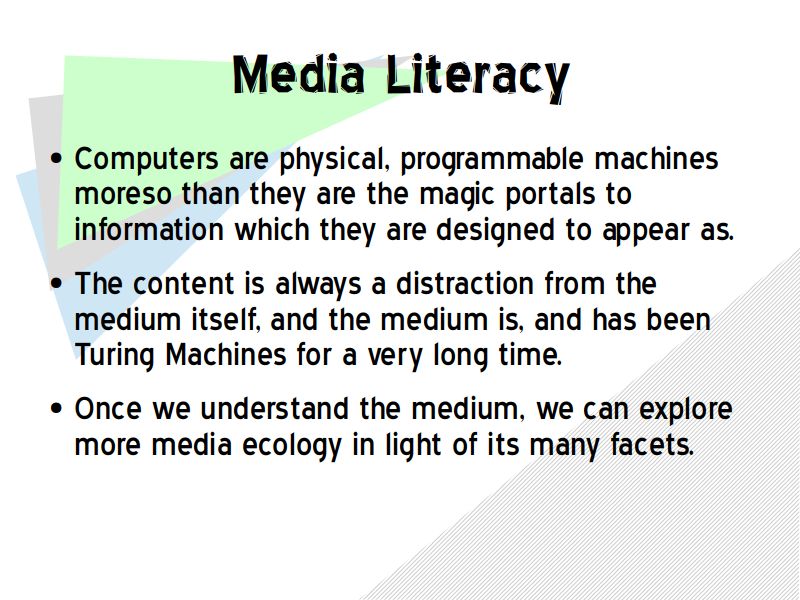
Once we all understand smart-devices and social media as merely the latent incarnation of the almost-unchanging, decade’s old machines they are, instead of the rapidly-obsolesced disposable consumer flotsam of the maelstrom that they are marketed as, we’ll have established some rock solid historical and technical grounding upon which to stand and catch a breath.
From this anti-environment, as McLuhan would call it, will can open all-new avenues for exploration in our connected age. We will be using McLuhan’s media theory, which posits all technologies and media as extensions of ourselves ,and electronic media as extensions of our “nervous systems”. We will compare what it means to sense computers as physical devices, vs. computers as portals to otherworldly cyberspace.
This is going to take us a far toward grasping lots of contemporary thinking on trans-humanism, post-humanism, etc. This is because, I dare say, McLuhan is the point of inception for such thinking. But don’t worry, it’s just metaphoric here. The ideas is that by studying this stuff directly we can learn to keep technology at a safe distance, see it for what it is, and up the resolution in our thinking about our devices to always be conscious about our uses of them. This series is pro-human, cyborg-weary. If you want to be lead around by machines your whole life, I’m at least trying to help you make that decision more fully informed.
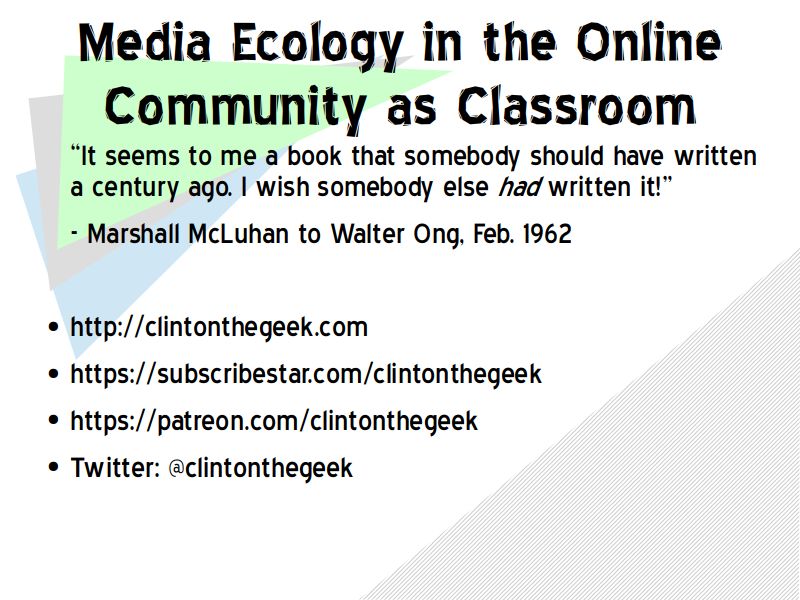
And then, only then, after laying that groundwork, once we know just what computers are and where they come from, will we be able to being talking about online communities, learning, social media, internet flamewars , trolls shame brigades, traditional media, etc. It’s silly to try and talk about those things when you’ve haven’t a handle of what’s going on under your very nose!
Leave a Reply